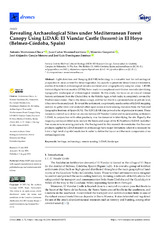Mostrar el registro sencillo del ítem
Revealing Archaeological Sites under Mediterranean Forest Canopy Using LiDAR: El Viandar Castle (husum) in El Hoyo (Belmez-Córdoba, Spain)
| dc.contributor.author | Monterroso-Checa, Antonio | |
| dc.contributor.author | Moreno-Escribano, Juan Carlos | |
| dc.contributor.author | Gasparini, Massimo | |
| dc.contributor.author | Conejo-Moreno, José Alejandro | |
| dc.contributor.author | Domínguez-Jiménez, José Luis | |
| dc.date.accessioned | 2021-09-03T11:22:37Z | |
| dc.date.available | 2021-09-03T11:22:37Z | |
| dc.date.issued | 2021 | |
| dc.identifier.uri | http://hdl.handle.net/10396/21553 | |
| dc.description.abstract | Light detection and Ranging (LiDAR) technology is a valuable tool for archaeological prospection in areas covered by dense vegetation. Its capacity to penetrate dense forest environments enables it to detect archaeological remains scattered over orographically complex areas. LiDAR-derived digital terrain models (DTMs) have made an exceptional contribution towards identifying topographic landscapes of archaeological interest. In this study, we focus on an area of intense historic settlement from the Chalcolithic to the Middle Ages, which today is completely covered by Mediterranean forest. Due to the dense canopy, and the fact that it is a protected area on private land, it has never been analyzed. To reveal the settlement, we primarily used a series of LiDAR mapping surveys to gather data and analyzed other open access remote sensing resources from the National Geographic Institute of Spain (IGN). The IGN LiDAR data proved to be of particular interest. These resources enabled us to detect an ancient fortress (El Viandar Castle) and its surrounding settlement. LiDAR, in conjunction with other products, was fundamental in identifying the site. Equally, the mapping surveys enabled us to analyze the limits and scope of the IGN airborne LiDAR and other free access remote sensing products. Our background in this research demonstrates that low-cost products applied to LiDAR research in archaeology have major limitations when it is necessary to have a high level of spatial resolution in order to define the layout and the main components of an archaeological site. | es_ES |
| dc.format.mimetype | application/pdf | es_ES |
| dc.language.iso | eng | es_ES |
| dc.publisher | MDPI | es_ES |
| dc.rights | https://creativecommons.org/licenses/by/4.0/ | es_ES |
| dc.source | Drones 2021, 5(3), 72 (2021) | es_ES |
| dc.subject | Heritage | es_ES |
| dc.subject | Archaeology | es_ES |
| dc.subject | Remote sensing | es_ES |
| dc.subject | LiDAR | es_ES |
| dc.subject | Landscape | es_ES |
| dc.title | Revealing Archaeological Sites under Mediterranean Forest Canopy Using LiDAR: El Viandar Castle (husum) in El Hoyo (Belmez-Córdoba, Spain) | es_ES |
| dc.type | info:eu-repo/semantics/article | es_ES |
| dc.relation.publisherversion | https://doi.org/10.3390/drones5030072 | es_ES |
| dc.relation.projectID | Junta de Andalucía. UCO-FEDER 2018 1265775-F | es_ES |
| dc.rights.accessRights | info:eu-repo/semantics/openAccess | es_ES |

